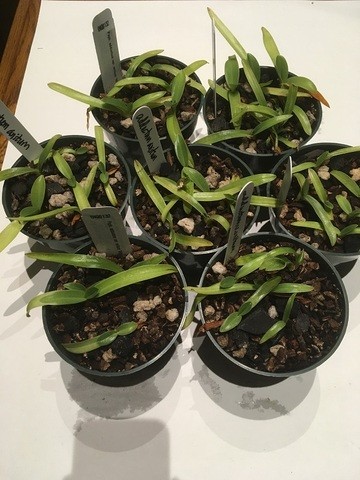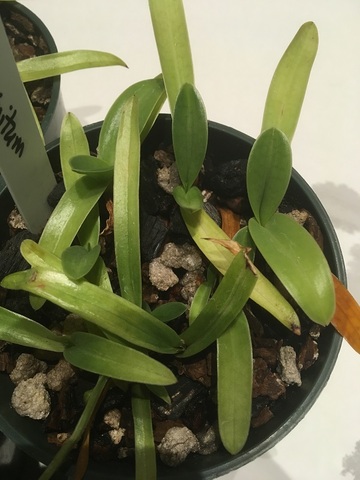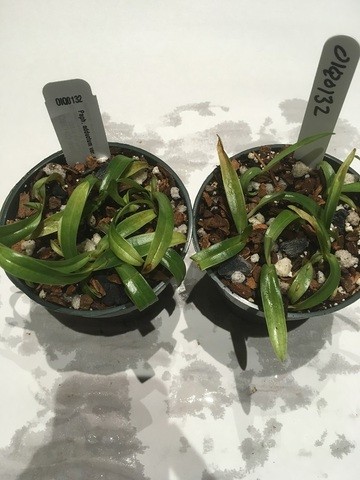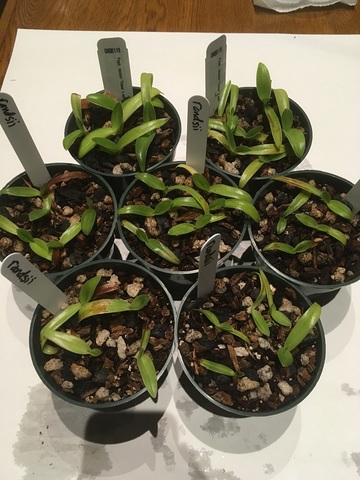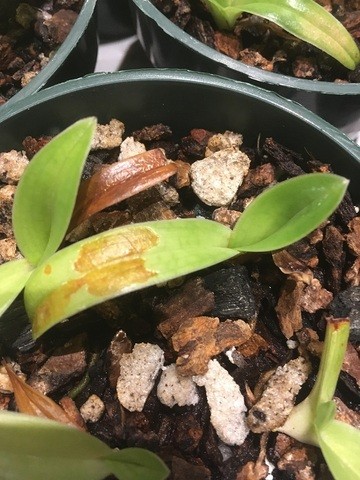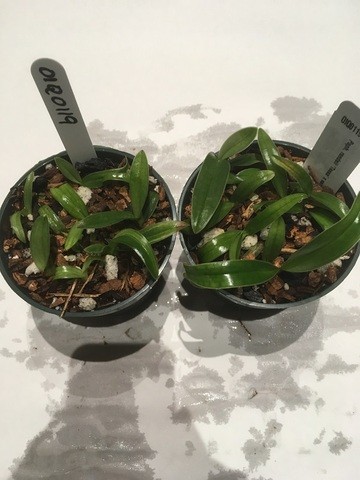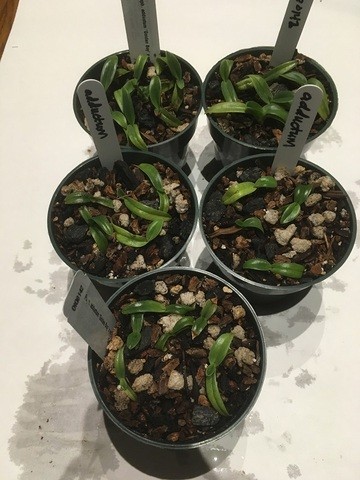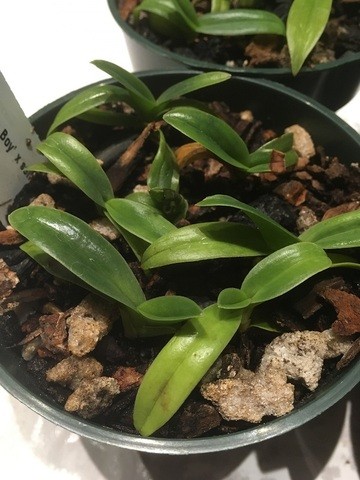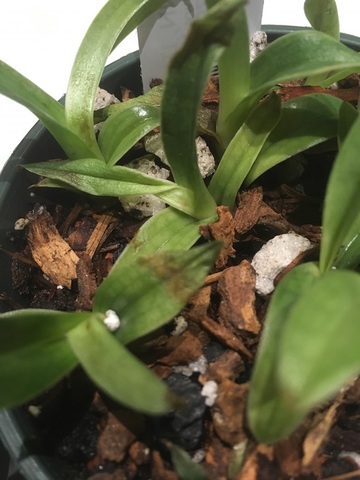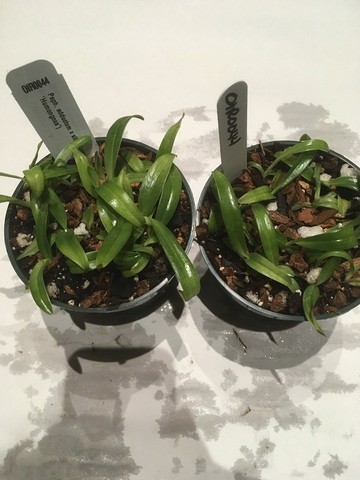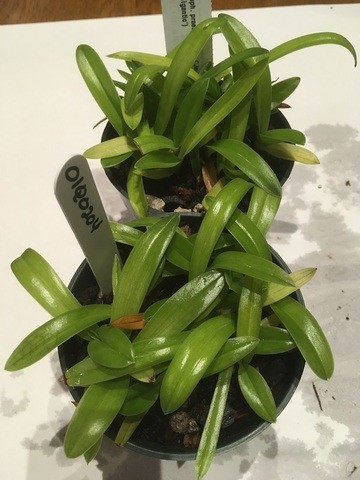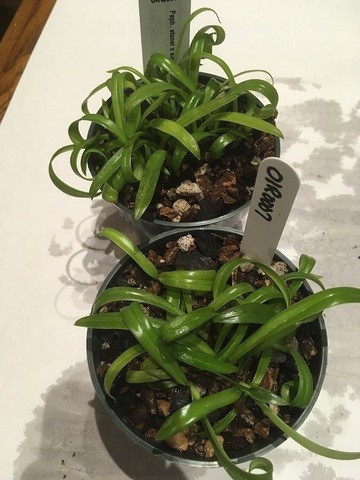The Coryopedilum Chronicles VIII – Nine month status review
This Chronicle documents the status of two flasks each of Paphiopedilum sanderianum, rothschildianum, platyphyllum, adductum v. anitum and randsii nine months after they were deflasked and placed into compots.
In Chronicles VIII, there are a few new additions. As discussed below, with randsii and adductum var. anitum recovering slowly but surely from excessive light levels, I was able to obtain an additional flask of each from the exact same cross recently so that we can observe how those plants fare in comparison growing in more ideal conditions from the start. I have also added a new selfing and a new sib cross of adductum to keep things interesting. All of these were deflasked within the last few days. Please note also that Paph. stonei now joins the mix, having been deflasked just before Chronicles VII was posted.
The status of each species is presented in a separate section, along with photographs.
Growing conditions - updated
The compots are indoors, with the adductum, adductum v. anitum and randsii recently moved to a room that is a bit warmer in winter than the bathroom where the rest of the plants are living. No natural light. Artificial light is provided by two Phillips T8 32W 48” Natural Light bulbs, 2850 lumens, 5000k bulbs that are approximately 15 inches above the leaves. Until four months ago, the plants were 18 inches from four bulbs on each shelf, and that proved to be quite excessive.
Watering has been out of the tap for seven months with no ill effect. No fertilizers or other supplements have been applied, and at this point none are planned until the plants are in individual pots. As the plants grow and compots get crowded, watering is back up to 3 times a week (from twice during the last Chronicles 3 month period) for compots, with watering 3-4 times a week for adductum, adductum var. anitum, randsii and plants in individual pots.
Temperature and humidity are monitored on an ongoing basis. Currently, humidity is ranging from 58% to 68% and temperatures as high as 73 during the day, with a low of 68 at night. Temperatures for the adductum, adductum v. anitum and randsii have been similar, but 2-3 degrees higher during cold snaps when the central heating was on (which is more concentrated in the room they now occupy.)
Plant losses
Now that the plants are much older, losses are rare and so I am no longer tracking them.
Paphiopedilum sanderianum
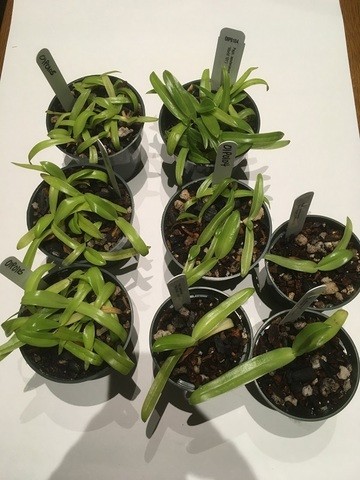
The three compots that were potted with the agar removed are on the left, and the two with agar partially intact are on the right- along with 3 seedlings that got so large they had to be potted out.
These continue to do well and are growing nicely. With the light levels now corrected, these are starting to darken a bit to a more ideal leaf color, and the compots will all need to be potted out fairly soon.
The plants potted with agar intact continue to be a bit ahead of the plants with agar removed, but the larger plants in the compots with agar removed actually seem to be growing at a faster rate now. Unfortunately, in the case of sanderianum there were not two flasks of the same parentage available as was the case for the other species, so slight genetic differences might be having an impact.
Paphiopedilum rothschildianum
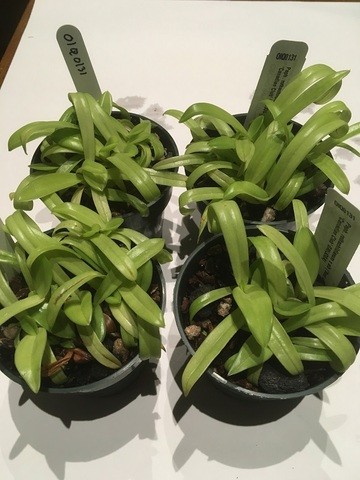
The two compots that were potted with the agar removed are on the left (they were fairly clumped in flask and so not individually separated- hence two compots vs three), and the two with agar partially intact are on the right.
As in the last update, at this point there is not a significant difference in performance between plants compotted with agar intact vs. agar removed, and these need to be potted out ASAP- hopefully this week if I can get around to it. Many will go back into compot, but the crowding of the plants is pretty intense.
Below is a photograph is of some of rothschildianum compots I deflasked in November, and which have been growing under the new reduced lighting scheme from the start. I post them here to show the ideal leaf color they have maintained. The rothschildianum that have been the subject of these Chronicles are still growing well, but the color of the leaves has not darkened to a more ideal shade at the same pace as has been the case with the other plants. Will be interesting to see how that progresses.
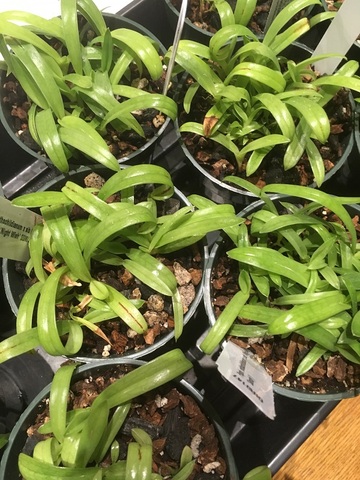
Paphiopedilum platyphyllum
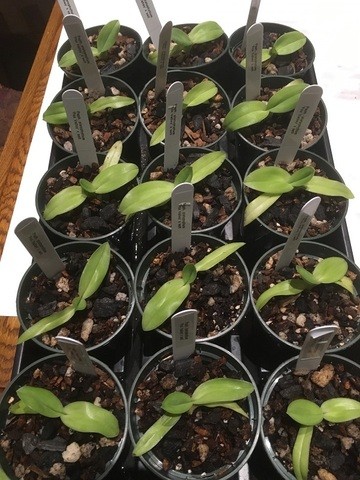
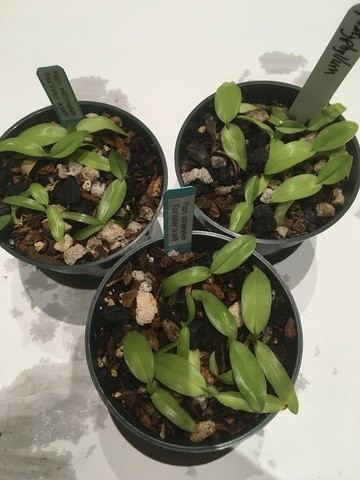
Aside from a number of smaller plants with few roots that went back into compot, these are all in pots now. At this point, two flasks have yielded 33 individual seedlings and 16 strong plants still in compot. Approximately 10-15 tiny seedlings that did not grow well were discarded after being given 9 months to show some progress. All in all, this is about as good an outcome as one can get IMHO.
Of all the species, these had the least negative reaction to the higher light levels previously in effect, but do note that some of the smallest flask leaves were starting to yellow slightly and have died off. New leaves are slightly darker in color and showing excellent width as they emerge.
While the leaf growth has been exceptional, these have still been slow to root and the flask roots plus any new roots appear to remain near the surface. As such, these sometimes get an extra watering during the week. They are very quick to show their displeasure when they are getting too dry by the way- you can see it in plants with a very early stage new leaf. Those leaves actually close up when water is needed- and open right back up once they are getting enough water. These physical reactions take place, in either direction, within a 24 hour period.
This Chronicle documents the status of two flasks each of Paphiopedilum sanderianum, rothschildianum, platyphyllum, adductum v. anitum and randsii nine months after they were deflasked and placed into compots.
In Chronicles VIII, there are a few new additions. As discussed below, with randsii and adductum var. anitum recovering slowly but surely from excessive light levels, I was able to obtain an additional flask of each from the exact same cross recently so that we can observe how those plants fare in comparison growing in more ideal conditions from the start. I have also added a new selfing and a new sib cross of adductum to keep things interesting. All of these were deflasked within the last few days. Please note also that Paph. stonei now joins the mix, having been deflasked just before Chronicles VII was posted.
The status of each species is presented in a separate section, along with photographs.
Growing conditions - updated
The compots are indoors, with the adductum, adductum v. anitum and randsii recently moved to a room that is a bit warmer in winter than the bathroom where the rest of the plants are living. No natural light. Artificial light is provided by two Phillips T8 32W 48” Natural Light bulbs, 2850 lumens, 5000k bulbs that are approximately 15 inches above the leaves. Until four months ago, the plants were 18 inches from four bulbs on each shelf, and that proved to be quite excessive.
Watering has been out of the tap for seven months with no ill effect. No fertilizers or other supplements have been applied, and at this point none are planned until the plants are in individual pots. As the plants grow and compots get crowded, watering is back up to 3 times a week (from twice during the last Chronicles 3 month period) for compots, with watering 3-4 times a week for adductum, adductum var. anitum, randsii and plants in individual pots.
Temperature and humidity are monitored on an ongoing basis. Currently, humidity is ranging from 58% to 68% and temperatures as high as 73 during the day, with a low of 68 at night. Temperatures for the adductum, adductum v. anitum and randsii have been similar, but 2-3 degrees higher during cold snaps when the central heating was on (which is more concentrated in the room they now occupy.)
Plant losses
Now that the plants are much older, losses are rare and so I am no longer tracking them.
Paphiopedilum sanderianum

The three compots that were potted with the agar removed are on the left, and the two with agar partially intact are on the right- along with 3 seedlings that got so large they had to be potted out.
These continue to do well and are growing nicely. With the light levels now corrected, these are starting to darken a bit to a more ideal leaf color, and the compots will all need to be potted out fairly soon.
The plants potted with agar intact continue to be a bit ahead of the plants with agar removed, but the larger plants in the compots with agar removed actually seem to be growing at a faster rate now. Unfortunately, in the case of sanderianum there were not two flasks of the same parentage available as was the case for the other species, so slight genetic differences might be having an impact.
Paphiopedilum rothschildianum

The two compots that were potted with the agar removed are on the left (they were fairly clumped in flask and so not individually separated- hence two compots vs three), and the two with agar partially intact are on the right.
As in the last update, at this point there is not a significant difference in performance between plants compotted with agar intact vs. agar removed, and these need to be potted out ASAP- hopefully this week if I can get around to it. Many will go back into compot, but the crowding of the plants is pretty intense.
Below is a photograph is of some of rothschildianum compots I deflasked in November, and which have been growing under the new reduced lighting scheme from the start. I post them here to show the ideal leaf color they have maintained. The rothschildianum that have been the subject of these Chronicles are still growing well, but the color of the leaves has not darkened to a more ideal shade at the same pace as has been the case with the other plants. Will be interesting to see how that progresses.

Paphiopedilum platyphyllum


Aside from a number of smaller plants with few roots that went back into compot, these are all in pots now. At this point, two flasks have yielded 33 individual seedlings and 16 strong plants still in compot. Approximately 10-15 tiny seedlings that did not grow well were discarded after being given 9 months to show some progress. All in all, this is about as good an outcome as one can get IMHO.
Of all the species, these had the least negative reaction to the higher light levels previously in effect, but do note that some of the smallest flask leaves were starting to yellow slightly and have died off. New leaves are slightly darker in color and showing excellent width as they emerge.
While the leaf growth has been exceptional, these have still been slow to root and the flask roots plus any new roots appear to remain near the surface. As such, these sometimes get an extra watering during the week. They are very quick to show their displeasure when they are getting too dry by the way- you can see it in plants with a very early stage new leaf. Those leaves actually close up when water is needed- and open right back up once they are getting enough water. These physical reactions take place, in either direction, within a 24 hour period.





